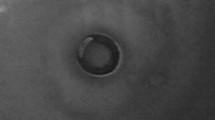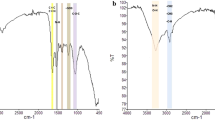Abstract
The present study was conducted to isolate and explore bacterial strains with a potential to sequester lead (Pb) and tolerate other heavy metals from industrial effluents and sediments. Out of the six bacterial strains isolated from seleniferous sites of Punjab, three isolates (RS-1, RS-2, and RS-3) were screened out for further growth-associated lead sequestration and molecular characterization on the basis of their tolerance toward lead and other heavy metals. Biomass and cell-free supernatant were analyzed for lead contents using ICP-MS after growth-associated lead sequestration studies in tryptone soya broth (pH = 7.2 ± 0.2) under aerobic conditions at 37 °C temperature. Almost 82 % and 70 % divalent lead was sequestered in cell pellets of RS-1 and RS-3, respectively while only 45 % of lead was found in cell pellet of RS-2 in the first 24 h. However, significant biosequestration of lead was observed in RS-2 after 48 h of incubation with concomitant increase in biomass. Simultaneously, morphological, biochemical, and physiological characterization of selected strains was carried out. 16S rRNA gene sequence of these isolates revealed their phylogenetic relationship with class Bacillaceae, a low G + C firmicutes showing 98 % homology with Bacillus sp.



Similar content being viewed by others
References
Ahmad E, Zaidi A, Khan MS, Oves M (2012) Heavy metal toxicity to symbiotic nitrogen-fixing microorganism and host legumes. In: Zaidi A, Wani PA, Khan MS (eds) Toxicity of Heavy Metals to Legumes and Bioremediation. Springer Verlag Wein, New York, pp 29–44
Alfven T, Jarup L, Elinder CG (2002) Cadmium and lead in blood in relation to low bone mineral density and tubular proteinuria. Environ Health Perspect 110:699–702
Al-Garni SM (2005) Biosorption of lead by Gram-negative capsulated and non-capsulated bacteria. Water SA 31:3
Altschul SF, Thomas LM, Alejandro AS, Zhang J, Miller W, Lipman DJ (1997) Gapped BLAST and PSI-BLAST: a new generation of protein database search programs. Nucl Acid Res 25:3389–3402
Chen J, Qin J, Zhu Y, Lorenzo V, Rosen BP (2013) Engineering the soil bacterium Pseudomonas putida for arsenic methylation. Appl Environ Microbiol 79:4493–4495
Cole JR, Chai B, Farris RJ, Wang Q, Kulam-Syed-Mohidden AS, McGarrell DM, Bandela AM, Cardenas E, Garrity GM, Tieje JM (2007) The ribosomal database project (RDP-II): introducing my RDP space and quality controlled public data. Nucl Acid Res 35(Database issue):D169–D172
Deng L, Su Y, Su H, Wang X, Zhu X (2007) Sorption and desorption of lead (II) from wastewater by green algae Cladophora fascicularis. J Haz Mat 143:220–225
Dhanjal S, Cameotra SS (2010) Aerobic biogenesis of selenium nanospheres by Bacillus cereus isolated from coalmine soil. Microb Cell Fact 9:52
Dhankher OP, Li Y, Rosen BP, Shi J, Salt D, Senecoff JF, Sashti NA, Meagher RB (2002) Engineering tolerance and hyper accumulation of arsenic in plants by combining arsenate reductase and gamma-glutamylcysteine synthetase expression. Nat Biotechnol 20:1140–1145
Edwards S, Kjellerup BV (2013) Applications of biofilms in bioremediation and biotransformation of persistent organic pollutants, pharmaceuticals/personal care products, and heavy metals. Appl Microbiol Biotechnol 97:9909–9921
Felsenstein J (1985) Confidence limits on phylogenies: An approach using the bootstrap. Evolution 39:783–791
Gadd GM (1990) Heavy metal accumulation by bacteria and other microorganisms. Experientia 46:834–840
Gonzalez AG, Shirokova LS, Pokrovsky OS, Emnova EE, Martinez RE, Santana-Casiano JM, Gonzalez-Davila M, Pokrovski GS (2010) Adsorption of copper on Pseudomonas aureofaciens : Protective role of surface exopolysaccharides. J Coll Inter Sci 350:305–314
Gupta VK, Ali I (2004) Removal of lead and chromium from waste-water using bagasse fly ash—a sugar industry waste. J Colloid Interface Sci 271:321–328
Gupta S, Nirwan J (2014) Evaluation of mercury biotransformation by heavy metal-tolerant Alcaligenes strain isolated from industrial sludge. Int J Environ Sci Technol. doi:10.1007/s13762-013-0484-9
Gupta S, Prakash R, Tejoprakash N et al (2010) Selenium mobilization of Pseudomonas aeruginosa (SNT-SG1) isolated from seleniferous soils from India. Geomicrobiol J 27:35–42
Gupta S, Goyal R, Nirwan J, Cameotra SS, Tejoprakash N (2012) Bio sequestration, transformation and volatilization of mercury by Lysinibacillus fusiformis isolated from industrial effluent. J Microbiol Biotechnol 22:684–689
Gutierrez T, Biller DV, Shimmield T, Green DH (2012) Metal binding properties of the EPS produced by Halomonas sp. TG39 and its potential in enhancing trace element bioavailability to eukaryotic phytoplankton. Biometals 25:1185–1194
Halttunen T (2007) Removal of lead, cadmium and arsenic from water by lactic acid bacteria. Dissertation, Department of Biochemistry and Food Chemistry, University of Turku, Turku
Hayes AW (2007) Principles and methods of toxicology. Taylor & Francis press, Philadelphia
Howlett NG, Avery SV (1997) Induction of lipid peroxidation during heavy metal stress in Saccharomyces cerevisiae and influence of plasma membrane fatty acid unsaturation. Appl Environ Microbiol 63:2971–2976
Iyer A, Mody K, Jha B (2005) Biosorption of heavy metals by a marine bacterium. Mar Poll Bull 50:340–343
Jaroslawiecka A, Piotrowska-Seget Z (2014) Lead resistance in micro-organisms. Microbiology 160:12–25
Jaysankar D, Ramaiah N, Vardanyan L (2008) Detoxification of toxic heavy metals by marine bacteria highly resistant to mercury. Mar Biotechnol 10:471–477
Kogej A, Likozar B, Pavko A (2010) Lead Biosorption by self-immobilized Rhizopus nigricans pellets in a laboratory scale packed bed column: mathematical model and experiment. Food Technol Biotechnol 48:344–351
Kumar A, Gupta S, Cameotra S (2012) Screening and characterization of potential cadmium biosorbent Alcaligenes strain from Industrial effluent. J Basic Microbiol 52:160–166
Lemire JA, Harrison JJ, Turner RJ (2013) Antimicrobial activity of metals: mechanisms, molecular targets and applications. Nat Rev Microbiol 11:371–384
Luoma SN, Rainbow PS (2008) Metal contamination in aquatic environments: science and lateral management. Cambridge University Press, Cambridge
Maidak BL, Cole JR, Lilburn TG, Parker CT Jr, Saxman PR, Farris RJ, Garrity GM, Olsen GJ, Schmidt TM, Tiedje JM (2001) The RDP-II (ribosomal database project). Nucl Acid Res 29:173–174
Malik A (2004) Metal bioremediation through growing cells. Environ Inter 30:261–278
McLaughlin MJ, Parker DR, Clarke JM (1999) Metals and micronutrients-food safety issues. Field Crop Res 60:143–163
Merroun, ML (2007) Interactions between metals and bacteria: fundamental and applied research In: Méndez-Vilas A (ed) Communicating current research and educational topics and trends in applied microbiology, pp 108–119
Mohamed RM, Abo-Amer AE (2012) Isolation and characterization of heavy-metal resistant microbes from roadside soil and phylloplane. J Basic Microbiol 52:53–65
Nies DH (1999) Microbial heavy-metal resistance. Appl Microbiol Biotechnol 51:730–750
Nordberg G (2003) Cadmium and human health: a perspective based on recent studies in China. J Trace Elem Exp Med 16:307–319
Peralta-Videa JR, Lopez ML, Narayan M, Saupe G, Gardea-Torresdey J (2009) The biochemistry of environmental heavy metal uptake by plants: Implications for the food chain. Int J Biochem Cell Biol 41:1665–1677
Rico M, Lopez A, Santana-Casiano JM, Gonzalez AG, Gonzalez-Davila M (2013) Variability of the phenolic profile in the diatom Phaeodactylum tricornutum growing under copper and iron stress. Limnol Oceanogr 58:144–152
Roane TM, Josephson KL, Pepper IL (2001) Dual-bioaugmentation strategy to enhance remediation of co-contaminated soil. Appl Environ Microbiol 67:3208–3215
Sambrook J, Fritsch EF, Maniatis T (1989) Molecular cloning: a laboratory manual. Cold Spring Harbor press, New York
Schaller J, Weiske A, Mkandawire M, Dudel EG (2010) Invertebrates control metals and arsenic sequestration as ecosystem engineers. Chemosphere 79:169–173
Singh SK, Tripathi VR, Jain RK, Vikram S, Garg SK (2010) An antibiotic, heavy metal resistant and halotolerant Bacillus cereus SIU1 and its thermoalkaline protease. Microb Cell Fact 9:59
Sulaymon AH, Ebrahim SE, Mohammed-Ridha MJ (2013) Equilibrium, kinetic, and thermodynamic biosorption of Pb (II), Cr (III), and Cd (II) ions by dead anaerobic biomass from synthetic wastewater. Environ Sci Pollut Res 20:175–187
Tamura K, Stecher G, Peterson D, Filipski A, Kumar S (2013) MEGA6: Molecular Evolutionary Genetics Analysis version 6.0. Mol Biol Evol 30:2725–2729
Thomson JD, Higgins DG, Gibson TJ (1994) CLUSTALW: improving the sensitivity of progressive multiple sequence alignment through sequence weighting, positions-specific gap penalties and weight matrix choice. Nucl Acid Res 22:4673–4680
Veglio F, Beolchini F (1997) Removal of metals by biosorption: A review. Hydrometall 44:301–316
Vieira DM, Augusto da Costa AC, Henriques CA, Cardoso VL, Pessoa de Franca F (2007) Biosorption of lead by the brown seaweed Sargassum filipendula—batch and continuous pilot studies. Elec J Biotech 10:369–375
Volesky B (1990) Biosorption of heavy metals. CRC Press, Boca Raton
Wang Q, Garrity GM, Tiedje JM, Cole JR (2007) Naive Bayesian classifier for rapid assignment of rRNA sequences into the new bacterial taxonomy. Appl Environ Microbiol 73:5261–5267
White C, Wilkinson SC, Gadd GM (1995) The role of microorganisms in biosorption of toxic metals and radionuclides. Intern Biodeterior Biodegrad 35:17–40
Yetis U, Dolek A, Dilek FB, Ozcengiz G (2000) The removal of Pb (II) by Phanerochaete chrysosporium. Water Res 34:4090–4100
Author information
Authors and Affiliations
Corresponding author
Additional information
Responsible editor: Robert Duran
Rights and permissions
About this article
Cite this article
Gupta, S., Goyal, R. & Prakash, N.T. Biosequestration of lead using Bacillus strains isolated from seleniferous soils and sediments of Punjab. Environ Sci Pollut Res 21, 10186–10193 (2014). https://doi.org/10.1007/s11356-014-2951-3
Received:
Accepted:
Published:
Issue Date:
DOI: https://doi.org/10.1007/s11356-014-2951-3




